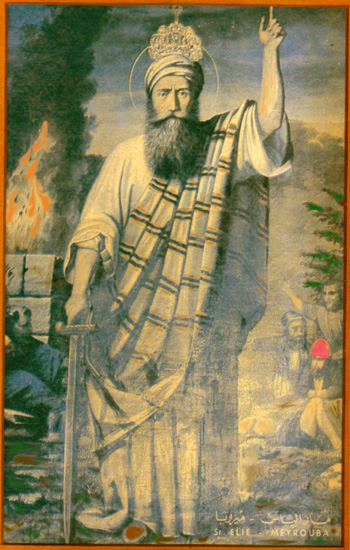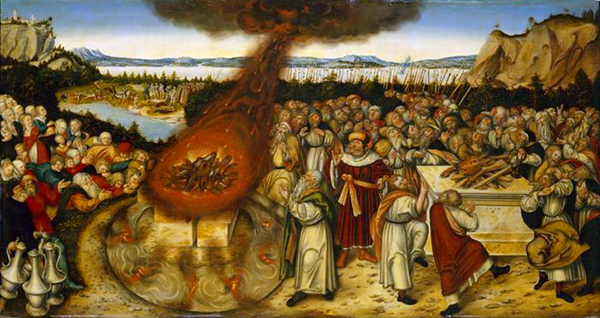Elias, the Prophet
Plinio Corrêa de Oliveira
I received a gift from a friend in Buenos Aires, a printed image representing Elias the Prophet
distributed by the Maronite Catholics there. This picture is venerated
by both the Catholics of Lebanon and those who live close to Mount
Carmel.
The Maronites report an interesting fact about this picture. It is one
of these legendary episodes, which expresses well the ambience where
the devotion of Elias developed among them.
There was a man who had stolen some goods and was caught. Brought before the authorities, he insistently denied the charge. So, the Maronites brought the man, an unbeliever, before this image of St. Elias and ordered him: “Now, look into Elias’ eyes and deny again that you are the thief.” When the man looked directly into the face of this figure of Elias, he became so frightened that he confessed his crime.
 Elias after slaying the prophets of Baal |
You can see that it is a quite Eastern figure. The gesture he is making has the emphasis – I would say the pomp – that can characterize a Prophet of the Old Testament. He is a powerful man who reminds me a little of the painting of Charlemagne by Dürer. His face has a light complexion, the gaze is fixed on one point and is penetrating. There is a great coherence in the expression of his physiognomy, in the position of his body and in the gestures of his arms.
You see the firmness with which he holds this sword. He is supporting himself on the sword, but at the same time this arm is in fully readiness to raise and use it.
Dr. J.F.C. is reminding me that in this picture Elias had just finished killing the 400 priests of Baal. If you recall, the Prophet Elias challenged more than 400 prophets of Baal to a contest to see whose God could send down fire from Heaven to consume a sacrificed bull. The false prophets prayed to Baal but their god was unable to start a fire.
Elias built an altar and dug a trench around it, filling it with water. Then, he prayed and God sent down a fire that consumed the holocaust and even the stones of the altar. Elias slew all the false prophets of Baal and commanded the people to abandon their idolatry.
So, all those men were beheaded with that sword. The least we can say is that this sword had worked a lot…
You see that the other arm takes a position of declamation, of recrimination. He is accusing the prophets of Baal – so it appears if we consider the fire at left and the slain man to his right. Or he is recriminating the people who are not faithful, represented by these three men at the right who are cringing before him. He is a fighter!
The warrior in him is also noticeable in his body. It is solid, even slightly heavyset. For my taste, it could have been represented a little more slender. He gives the impression of a man planted in the ground, rooted in the earth. And, no one can move him from the place where he stands.
There is nothing here, however, of a purely physical fighter. The flame in his gaze and the polemical demeanor of his whole physiognomy mark him much more than his muscular structure and the position of his body. His soul is more combative than his body and explains the combativeness of the body.
Although it is an Eastern image, it curiously follows a Western pattern with the colorful panorama [Note from the editor: Unfortunately in the copy we have at hand the original colors have faded significantly]. It has something of the freshness of a painting of Fra Angelico, at least in my opinion. One finds this, for example, in the small red hat of the one man to the right. If his hat were brown, the painting would lose some of its freshness. Note also the diaphanous light, the green of the plants, the blue sky and the beautiful fire. These are aspects that bring to my mind Fra Angelico.
Naturally, the apparel is typically Eastern: the turban topped by a small diadem, the mantle that covers the tunic. It is a discrete mantle, but it immediately catches the attention. The diadem contributes to the majesty of the personage and adds a picturesque Eastern detail: In the West it is very rare to represent a Prophet with a crown and, even rarer, with a diadem. It conforms quite well to the ensemble of Elias' personality.
His thick beard and the full mustache fortify the idea of a virile man.
This is one of the most interesting images I have seen depicting the Prophet Elias, which is why it seemed opportune to make a slide of it to show you and comment on it tonight.
 God sends fire from Heaven at Elias' prayer Painting by Lucas Cranach, 16th century |
